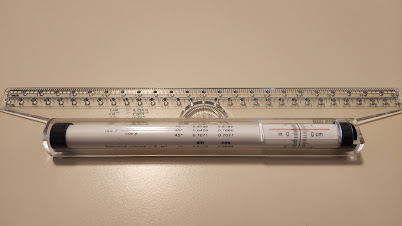What is it used for?
A fellow math teacher gave me this yesterday, knowing of my penchant for slide rules. It's not a slide rule; it looks like a combination ruler, protractor, and compass, with a few formulas and trig values thrown in for good measure. It says "Made in China", so I assume it's no older than the 90's.
At first I thought it might be some draftsman's tool, but closer inspection makes it seem like nothing more than an overgrown ruler.
Has anyone used one of these things? What might it be good for?
Yes, the bottom part rolls.
I think it's for drafting, where you want to constantly draw lines a fixed distance apart.
ReplyDeletehttps://www.youtube.com/watch?v=aCwWls0exVw&ab_channel=1stYearEngineeringDrawing
I have one of these; I first saw them in Hong Kong in the 90s.
ReplyDeleteThey have many names, but I know them as a "rolling ruler".
They were/are used for drawing neat geometric diagrams.
Here's the original ad: https://www.youtube.com/watch?v=Atj1o7T4dUU&ab_channel=BetamaxKing
It's a ruler and straight edge. The roller allows the user to make parallel lines.
ReplyDeleteFor instance, if you had a position-time graph, you might want to find the time at which an object has a certain velocity. You'd set the ruler to the right slope, then roll until it's tangent with the curve. It's probably good for vectors too.
Anything printed on the roller is just to take up space.
Seems like a lot of effort to make parallel lines, but thanks for all the information!
ReplyDeleteDrafting roller ruler. If you know how to use this, it can be much quicker than using a drafting t-square and drafting triangles. Some older "drafting-lettering triangles" (1970s) used the spaced holes to make parallel lines. Might be where the idea came from. Rollers are to keep the ruler moving at a 90 degree angle to the lines drawn. I've used it some, but I think using triangles are more accurate in pencil work. (Really says how old I am.)
ReplyDeleteI sent this post to the friend who gave me this tool. He and I agree that it would be useful for drawing parallel lines.
ReplyDeleteBoat navigation transfers a lot of parallel lines. The traditional device is two rulers with parallel linkages (think flexible parallelogram), but that takes up a fair amount of space to use. Small boat navigators use one of these instead. More likely to slip, but less real estate.
ReplyDelete